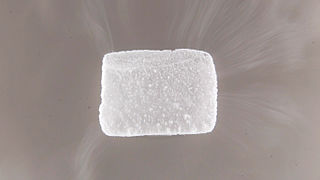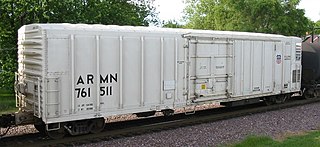
Refrigeration is any of various types of cooling of a space, substance, or system to lower and/or maintain its temperature below the ambient one. Refrigeration is an artificial, or human-made, cooling method.

Dry ice colloquially means the solid form of carbon dioxide. It is commonly used for temporary refrigeration as CO2 does not have a liquid state at normal atmospheric pressure and sublimes directly from the solid state to the gas state. It is used primarily as a cooling agent, but is also used in fog machines at theatres for dramatic effects. Its advantages include lower temperature than that of water ice and not leaving any residue (other than incidental frost from moisture in the atmosphere). It is useful for preserving frozen foods (such as ice cream) where mechanical cooling is unavailable.

A refrigerator car is a refrigerated boxcar (U.S.), a piece of railroad rolling stock designed to carry perishable freight at specific temperatures. Refrigerator cars differ from simple insulated boxcars and ventilated boxcars, neither of which are fitted with cooling apparatus. Reefers can be ice-cooled, come equipped with any one of a variety of mechanical refrigeration systems, or use carbon dioxide or liquid nitrogen as a cooling agent. Milk cars may or may not include a cooling system, but are equipped with high-speed trucks and other modifications that allow them to travel with passenger trains.
In United States patent law, patent misuse is a patent holder's use of a patent to restrain trade beyond enforcing the exclusive rights that a lawfully obtained patent provides. If a court finds that a patent holder committed patent misuse, the court may rule that the patent holder has lost the right to enforce the patent. Patent misuse that restrains economic competition substantially can also violate United States antitrust law.

An ice pack or gel pack is a portable bag filled with water, refrigerant gel, or liquid, meant to provide cooling. They can be divided into the reusable type, which works as a thermal mass and requires freezing, or the instant type, which cools itself down using chemicals but can only be used once. The instant type is generally limited to medical use as a cold compress to alleviate the pain of minor injuries, while the reusable type is both used as a cold compress and to keep food cool in portable coolers or in insulated shipping containers to keep products cool during transport.

An icemaker, ice generator, or ice machine may refer to either a consumer device for making ice, found inside a home freezer; a stand-alone appliance for making ice, or an industrial machine for making ice on a large scale. The term "ice machine" usually refers to the stand-alone appliance.

A refrigerated container or reefer is an intermodal container used in intermodal freight transport that is capable of refrigeration for the transportation of temperature-sensitive, perishable cargo such as fruits, vegetables, meat, fish, seafood, and other similar items.
Insulated shipping containers are a type of packaging used to ship temperature sensitive products such as foods, pharmaceuticals, organs, blood, biologic materials, vaccines and chemicals. They are used as part of a cold chain to help maintain product freshness and efficacy. The term can also refer to insulated intermodal containers or insulated swap bodies.

Aro Manufacturing Co. v. Convertible Top Replacement Co., 365 U.S. 336 (1961), is a United States Supreme Court case in which the Court redefined the U.S. patent law doctrine of repair and reconstruction. The decision is sometimes referred to as Aro I because several years later the Supreme Court readdressed the same issues in a second case in 1964 involving the same parties—Aro II.
United States v. General Electric Co., 272 U.S. 476 (1926), is a decision of the United States Supreme Court holding that a patentee who has granted a single license to a competitor to manufacture the patented product may lawfully fix the price at which the licensee may sell the product.
A post-sale restraint, also termed a post-sale restriction, as those terms are used in United States patent law and antitrust law, is a limitation that operates after a sale of goods to a purchaser has occurred and purports to restrain, restrict, or limit the scope of the buyer's freedom to utilize, resell, or otherwise dispose of or take action regarding the sold goods. Such restraints have also been termed "equitable servitudes on chattels".

Once an invention is patented in Canada, exclusive rights are granted to the patent holder as defined by s.42 of the Patent Act. Any interference with the patent holder's "full enjoyment of the monopoly granted by the patent" is considered a patent infringement. Making, constructing, using, or selling a patented invention without the patent holder's permission can constitute infringement. Possession of a patented object, use of a patented object in a process, and inducement or procurement of an infringement may also, in some cases, count as infringement.
Morton Salt Co. v. G.S. Suppiger Co., 314 U.S. 488 (1942), is a patent misuse decision of the United States Supreme Court. It was the first case in which the Court expressly labeled as "misuse" the Motion Picture Patent/Carbice tie-in defense to a charge of patent infringement and created the present blanket remedy in infringement cases of unenforceability of the misused patent. The decision re-emphasized that misuse can be found without finding an antitrust violation.
Motion Picture Patents Co. v. Universal Film Mfg. Co., 243 U.S. 502 (1917), is United States Supreme Court decision that is notable as an early example of the patent misuse doctrine. It held that, because a patent grant is limited to the invention described in the claims of the patent, the patent law does not empower the patent owner, by notices attached to the patented article, to extend the scope of the patent monopoly by restricting the use of the patented article to materials necessary for their operation but forming no part of the patented invention, or to place downstream restrictions on the articles making them subject to conditions as to use. The decision overruled The Button-Fastener Case, and Henry v. A.B. Dick Co., which had held such restrictive notices effective and enforceable.
Henry v. A.B. Dick Co., 224 U.S. 1 (1912), was a 1912 decision of the United States Supreme Court that upheld patent licensing restrictions such as tie-ins on the basis of the so-called inherency doctrine—the theory that it was the inherent right of a patent owner, because he could lawfully refuse to license his patent at all, to exercise the "lesser" right to license it on any terms and conditions he chose. In 1917, the Supreme Court overruled the A.B. Dick case in Motion Picture Patents Co. v. Universal Film Mfg. Co.,

The Button-Fastener Case, Heaton-Peninsular Button-Fastener Co. v. Eureka Specialty Co., also known as the Peninsular Button-Fastener Case, was for a time a highly influential decision of the United States Court of Appeals for the Sixth Circuit. Many courts of appeals, and the United States Supreme Court in the A.B. Dick case adopted its "inherency doctrine"—"the argument that, since the patentee may withhold his patent altogether from public use, he must logically and necessarily be permitted to impose any conditions which he chooses upon any use which he may allow of it." In 1917, however, the Supreme Court expressly overruled the Button-Fastener Case and the A.B. Dick case, in the Motion Picture Patents case.
Leitch Manufacturing Co. v. Barber Co., 302 U.S. 458 (1938), is a 1938 decision of the United States Supreme Court extending the tie-in patent misuse doctrine to cases in which the patentee does not use an explicit tie-in license but instead relies on grants of implied licenses to only those who buy a necessary supply from it.
B.B. Chemical Co. v. Ellis, 314 U.S. 495 (1942), is a United States Supreme Court decision involving the patent misuse doctrine and the extent of remedies a court should award after finding a misuse that the patentee alleges it has now discontinued. The Court ruled that to be able to enforce the patent against infringement the patentee must show that it has fully abandoned its unlawful practice and that the consequences of that practice have been fully dissipated. This was a companion case to Morton Salt Co. v. G.S. Suppiger Co. decided on the same day.
The Mercoid cases—Mercoid Corp. v. Mid-Continent Investment Co., 320 U.S. 661 (1944), and Mercoid Corp. v. Minneapolis-Honeywell Regulator Co., 320 U.S. 680 (1944)—are 1944 patent tie-in misuse and antitrust decisions of the United States Supreme Court. These companion cases are said to have reached the "high-water mark of the patent misuse doctrine." The Court substantially limited the contributory infringement doctrine by holding unlawful tie-ins of "non-staple" unpatented articles that were specially adapted only for use in practicing a patent, and the Court observed: "The result of this decision, together with those which have preceded it, is to limit substantially the doctrine of contributory infringement. What residuum may be left we need not stop to consider." The Court also suggested that an attempt to extend the reach of a patent beyond its claims could or would violate the antitrust laws: "The legality of any attempt to bring unpatented goods within the protection of the patent is measured by the antitrust laws, not by the patent law."
Dawson Chemical Co. v. Rohm & Haas Co., 448 U.S. 176 (1980), is a 1980 5–4 decision of the United States Supreme Court limiting the patent misuse doctrine and explaining the scope of the 1952 amendment of the patent laws that resurrected the contributory infringement doctrine in the wake of the Mercoid cases. The Mercoid cases and a few predecessor cases had denied relief against patent infringement to patentees who were deriving revenue from the sale of unpatented products used as supplies for patented combinations or as components of patented combinations, even when the unpatented products were specially adapted for use with the patented combinations and even when they lacked any utility other than that use. The patentees used contributory infringement suits or threats of such suits to enforce their business model, which the Mercoid cases outlawed.











